DAY3 - AOP
一、AOP简介
- AOP(Aspect Oriented Programming)面向切面编程,一种编程范式,指导开发者如何组织程序结构。
- 作用:在不惊动原始设计的基础上为其进行功能增强。
- Spring理念:无入侵式/无侵入式
1.1 AOP核心概念
连接点 (JoinPoint):程序执行过程中的任意位置,粒度为执行方法、抛出异常、设置变量等。
- 在SpringAOP中,理解为方法的执行
切入点(Pointcut):匹配连接点的式子
在SpringAOP中,一个切入点可以只描述一个具体方法,也可以匹配多个方法。
- 一个具体方法:com.li.dao包下的BookDao接口中的无形参无返回值的save方法
- 匹配多个方法:所有的save方法,所有的get开头的方法,所有以Dao结尾的接口中的任意方法,所有带有一个参数的方法。
通知(Advice):在切入点处执行的操作,也就是共性功能。
- 在SpringAOP中,功能最终以方法的形式呈现。
- 通知类:定义通知的类。
- 切面(Aspect):描述通知与切入点的对应关系。
1.1.1 示意图
1.1.2 实例
BookDaoImpl
@Repository
public class BookDaoImpl implements BookDao {
public void save() {
//记录程序当前执行执行(开始时间)
Long startTime = System.currentTimeMillis();
//业务执行万次
for (int i = 0;i<10000;i++) {
System.out.println("book dao save ...");
}
//记录程序当前执行时间(结束时间)
Long endTime = System.currentTimeMillis();
//计算时间差
Long totalTime = endTime-startTime;
//输出信息
System.out.println("执行万次消耗时间:" + totalTime + "ms");
}
public void update(){
System.out.println("book dao update ...");
}
public void delete(){
System.out.println("book dao delete ...");
}
public void select(){
System.out.println("book dao select ...");
}
}MyAdvice
@Component
@Aspect
public class MyAdvice {
@Pointcut("execution(* com.itheima.dao.BookDao.*d*(..))")
private void pt(){}
@Around("pt()")
public Object around(ProceedingJoinPoint pjp) throws Throwable {
System.out.println("------------------------------");
Long startTime = System.currentTimeMillis();
for (int i = 0 ; i<10000 ; i++) {
//调用原始操作
pjp.proceed();
}
Long endTime = System.currentTimeMillis();
Long totalTime = endTime-startTime;
System.out.println("执行万次消耗时间:" + totalTime + "ms");
return null;
}
}1.2 AOP作用
- 作用:在不惊动原始设计的基础上为其进行功能增强。
- 前面咱们有技术就可以实现这样的功能即代理模式。
二、AOP入门案例
2.1 AOP入门案例思路分析
2.2 实例
pom.xml
<?xml version="1.0" encoding="UTF-8"?>
<project xmlns="http://maven.apache.org/POM/4.0.0" xmlns:xsi="http://www.w3.org/2001/XMLSchema-instance"
xsi:schemaLocation="http://maven.apache.org/POM/4.0.0 http://maven.apache.org/xsd/maven-4.0.0.xsd">
<modelVersion>4.0.0</modelVersion>
<groupId>com.itheima</groupId>
<artifactId>spring_18_aop_quickstart</artifactId>
<version>1.0-SNAPSHOT</version>
<dependencies>
<dependency>
<groupId>org.springframework</groupId>
<artifactId>spring-context</artifactId>
<version>5.2.10.RELEASE</version>
</dependency>
<dependency>
<groupId>org.aspectj</groupId>
<artifactId>aspectjweaver</artifactId>
<version>1.9.4</version>
</dependency>
</dependencies>
</project>BookDao、BookDaoImpl(定义dao接口与实现类)
public interface BookDao {
public void save();
public void update();
}@Repository
public class BookDaoImpl implements BookDao {
public void save() {
System.out.println(System.currentTimeMillis());
System.out.println("book dao save ...");
}
public void update(){
System.out.println("book dao update ...");
}
}MyAdvice
- (定义通知类,制作通知)
- (定义切入点)
- (绑定切入点与通知关系,并指定通知添加到原始连接点的具体执行位置)
- (定义通知类受Spring容器管理,并定义当前类为切面类)
//通知类必须配置成Spring管理的bean
@Component
//设置当前类为切面类类
@Aspect
public class MyAdvice {
//设置切入点,要求配置在方法上方
@Pointcut("execution(void com.itheima.dao.BookDao.update())")
private void pt(){}
//设置在切入点pt()的前面运行当前操作(前置通知)
// @Before("pt()")
public void method(){
System.out.println(System.currentTimeMillis());
}
}- 说明:切入点定义依托一个不具有实际意义的方法进行,即无参数,无返回值,方法体无实际逻辑。
SpringConfig(开启Spring对AOP注解驱动支持)
@Configuration
@ComponentScan("com.itheima")
//开启注解开发AOP功能
@EnableAspectJAutoProxy
public class SpringConfig {
}2.3 知识点
三、AOP工作流程
3.1 AOP工作流程
3.2 AOP核心概念(新概念)
- 目标对象(Target):原始功能去掉共性功能对应的类产生的对象,这种对象是无法直接完成最终工作的。
- 代理(Proxy):目标对象无法直接完成工作,需要对其进行功能回填,通过原始对象的代理对象实现。
- SpringAOP本质:代理模式。
四、AOP配置管理 - AOP切入点表达式
(注:四~八皆为AOP配置管理)
4.1 实例
MyAdvice
@Component
@Aspect
public class MyAdvice {
//切入点表达式:
@Pointcut("execution(void com.itheima.dao.BookDao.update())")
@Pointcut("execution(void com.itheima.dao.impl.BookDaoImpl.update())")
@Pointcut("execution(* com.itheima.dao.impl.BookDaoImpl.update(*))") //no
@Pointcut("execution(void com.*.*.*.update())")
@Pointcut("execution(* *..*(..))")
@Pointcut("execution(* *..*e(..))")
@Pointcut("execution(void com..*())")
@Pointcut("execution(* com.itheima.*.*Service.find*(..))")
//执行com.itheima包下的任意包下的名称以Service结尾的类或接口中的save方法,参数任意,返回值任意
@Pointcut("execution(* com.itheima.*.*Service.save(..))")
private void pt(){}
@Before("pt()")
public void method(){
System.out.println(System.currentTimeMillis());
}
}
BookDaoImpl
@Repository
public class BookDaoImpl implements BookDao {
public void save() {
System.out.println("book dao save ...");
}
public void update(){
System.out.println("book dao update ...");
}
}BookDao
public interface BookDao {
public void save();
public void update();
}APP
public class App {
public static void main(String[] args) {
ApplicationContext ctx = new AnnotationConfigApplicationContext(SpringConfig.class);
BookDao bookDao = ctx.getBean(BookDao.class);
bookDao.update();
}
}4.2 书写技巧
五、AOP通知类型
- AOP通知描述了抽取的共性功能,根据共性功能抽取的位置不同,最终运行代码时要将其加入到合理的位置.
AOP通知共分为5种类型:
- 前置通知
- 后置通知
- 环绕通知(重点)
- 返回后通知(了解)
- 抛出异常后通知(了解)
5.1 实例
@Component
@Aspect
public class MyAdvice {
@Pointcut("execution(void com.itheima.dao.BookDao.update())")
private void pt(){}
@Pointcut("execution(int com.itheima.dao.BookDao.select())")
private void pt2(){}
//@Before:前置通知,在原始方法运行之前执行
@Before("pt()")
public void before() {
System.out.println("before advice ...");
}
//@After:后置通知,在原始方法运行之后执行
@After("pt2()")
public void after() {
System.out.println("after advice ...");
}
//@Around:环绕通知,在原始方法运行的前后执行
@Around("pt()")
public Object around(ProceedingJoinPoint pjp) throws Throwable {
System.out.println("around before advice ...");
//表示对原始操作的调用
Object ret = pjp.proceed();
System.out.println("around after advice ...");
return ret;
}
@Around("pt2()")
public Object aroundSelect(ProceedingJoinPoint pjp) throws Throwable {
System.out.println("around before advice ...");
//表示对原始操作的调用
Integer ret = (Integer) pjp.proceed();
System.out.println("around after advice ...");
return ret;
}
//@AfterReturning:返回后通知,在原始方法执行完毕后运行,且原始方法执行过程中未出现异常现象
@AfterReturning("pt2()")
public void afterReturning() {
System.out.println("afterReturning advice ...");
}
//@AfterThrowing:抛出异常后通知,在原始方法执行过程中出现异常后运行
@AfterThrowing("pt2()")
public void afterThrowing() {
System.out.println("afterThrowing advice ...");
}
}5.2 通知类型总结
@Before
@After
@Around
@Around注意事项
@AfterReturning
@AfterThrowing
六、案例︰测量业务层接口万次执行效率
6.1 案例需求分析
6.2 实例
@Component
@Aspect
public class ProjectAdvice {
//匹配业务层的所有方法
@Pointcut("execution(* com.itheima.service.*Service.*(..))")
private void servicePt(){}
//设置环绕通知,在原始操作的运行前后记录执行时间
@Around("ProjectAdvice.servicePt()")
public void runSpeed(ProceedingJoinPoint pjp) throws Throwable {
//获取执行的签名对象
Signature signature = pjp.getSignature();
String className = signature.getDeclaringTypeName();
String methodName = signature.getName();
long start = System.currentTimeMillis();
for (int i = 0; i < 10000; i++) {
pjp.proceed();
}
long end = System.currentTimeMillis();
System.out.println("万次执行:"+ className+"."+methodName+"---->" +(end-start) + "ms");
}
}七、AOP通知获取数据
7.1 获取参数
- JoinPoint :适用于前置、后置、返回后、抛出异常后通知。
- ProceedJointPoint :适用于环绕通知。
- JoinPoint对象描述了连接点方法的运行状态,可以获取到原始方法的调用参数。
- ProceedJointPoint是JoinPoint的子类。
7.2 获取返回值
- 返回后通知
- 环绕通知
- 抛出异常后通知可以获取切入点方法中出现的异常信息,使用形参可以接收对应的异常对象。
- 环绕通知中可以手工书写对原始方法的调用,得到的结果即为原始方法的返回值。
7.3 获取异常(了解)
- 抛出异常后通知
- 环绕通知
- 抛出异常后通知可以获取切入点方法中出现的异常信息,使用形参可以接收对应的异常对象。
- 抛出异常后通知可以获取切入点方法运行的异常信息,使用形参可以接收运行时抛出的异常对象。
7.4 实例
@Component
@Aspect
public class MyAdvice {
@Pointcut("execution(* com.itheima.dao.BookDao.findName(..))")
private void pt(){}
//JoinPoint:用于描述切入点的对象,必须配置成通知方法中的第一个参数,可用于获取原始方法调用的参数
// @Before("pt()")
public void before(JoinPoint jp) {
Object[] args = jp.getArgs();
System.out.println(Arrays.toString(args));
System.out.println("before advice ..." );
}
// @After("pt()")
public void after(JoinPoint jp) {
Object[] args = jp.getArgs();
System.out.println(Arrays.toString(args));
System.out.println("after advice ...");
}
//ProceedingJoinPoint:专用于环绕通知,是JoinPoint子类,可以实现对原始方法的调用
// @Around("pt()")
public Object around(ProceedingJoinPoint pjp) {
Object[] args = pjp.getArgs();
System.out.println(Arrays.toString(args));
args[0] = 666;
Object ret = null;
try {
ret = pjp.proceed(args);
} catch (Throwable t) {
t.printStackTrace();
}
return ret;
}
//设置返回后通知获取原始方法的返回值,要求returning属性值必须与方法形参名相同
@AfterReturning(value = "pt()",returning = "ret")
public void afterReturning(JoinPoint jp,String ret) {
System.out.println("afterReturning advice ..."+ret);
}
//设置抛出异常后通知获取原始方法运行时抛出的异常对象,要求throwing属性值必须与方法形参名相同
@AfterThrowing(value = "pt()",throwing = "t")
public void afterThrowing(Throwable t) {
System.out.println("afterThrowing advice ..."+t);
}
}八、案例:百度网盘密码数据兼容处理
8.1 案例需求分析
8.2 实例
开启SpringAOP的注解功能
@Configuration
@ComponentScan("com.itheima")
@EnableAspectJAutoProxy
public class SpringConfig {
}编写通知类 - 添加环绕通知 - 完成核心业务,处理参数中的空格
@Component
@Aspect
public class DataAdvice {
@Pointcut("execution(boolean com.itheima.service.*Service.*(*,*))")
private void servicePt(){}
@Around("DataAdvice.servicePt()")
public Object trimStr(ProceedingJoinPoint pjp) throws Throwable {
Object[] args = pjp.getArgs();
for (int i = 0; i < args.length; i++) {
//判断参数是不是字符串
if(args[i].getClass().equals(String.class)){
args[i] = args[i].toString().trim();
}
}
Object ret = pjp.proceed(args);
return ret;
}
}模拟校验
public class App {
public static void main(String[] args) {
ApplicationContext ctx = new AnnotationConfigApplicationContext(SpringConfig.class);
ResourcesService resourcesService = ctx.getBean(ResourcesService.class);
boolean flag = resourcesService.openURL("http://pan.baidu.com/haha", "root ");
System.out.println(flag);
}
}九、AOP总结
9.1 概念
- AOP —— 面向切面编程,一种编程范式。
9.2 作用
- 在不惊动原始设计的基础上为方法进行功能增强。

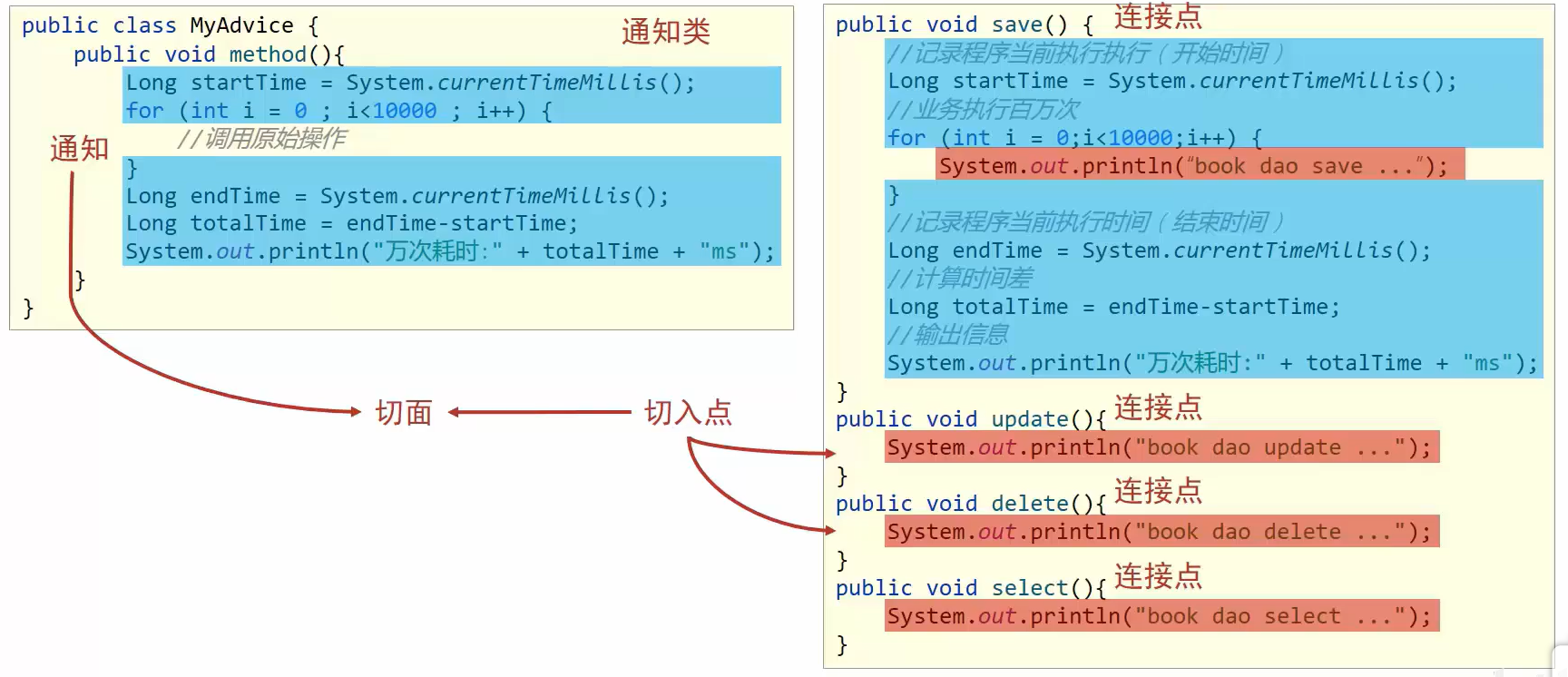
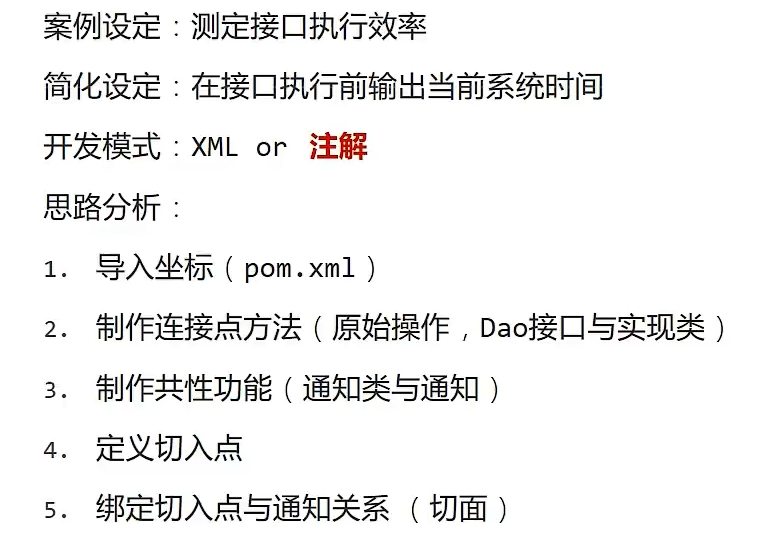
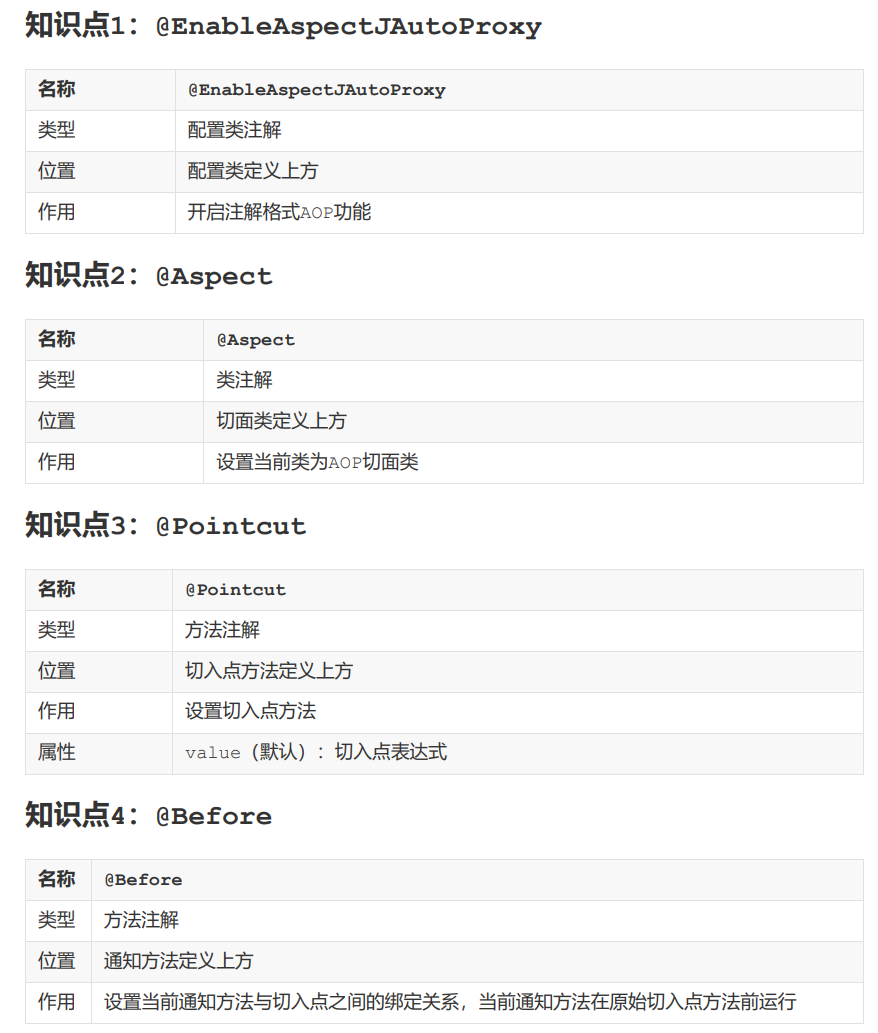
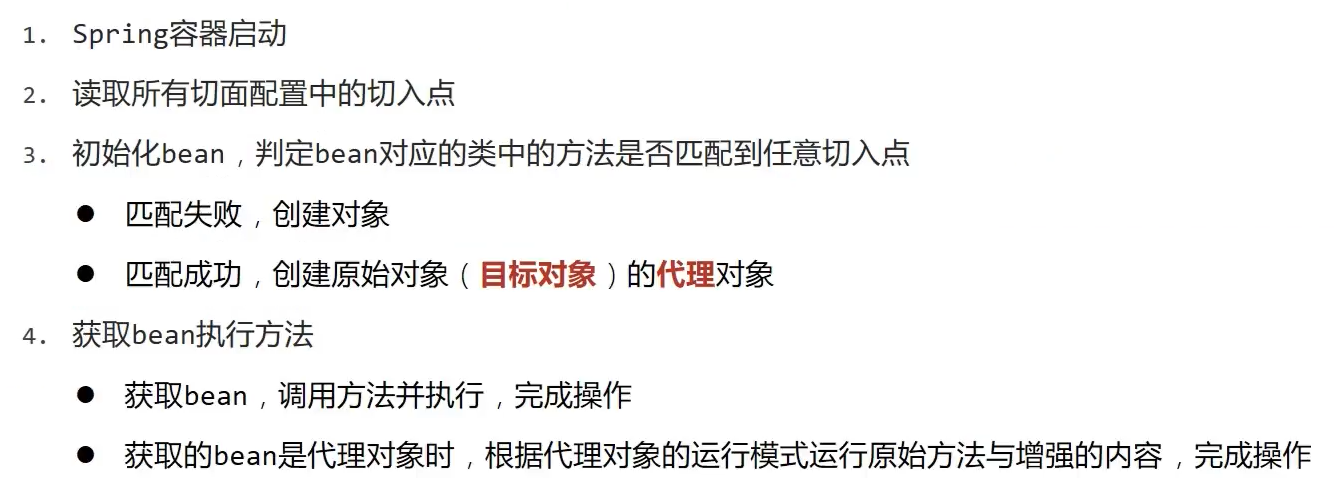

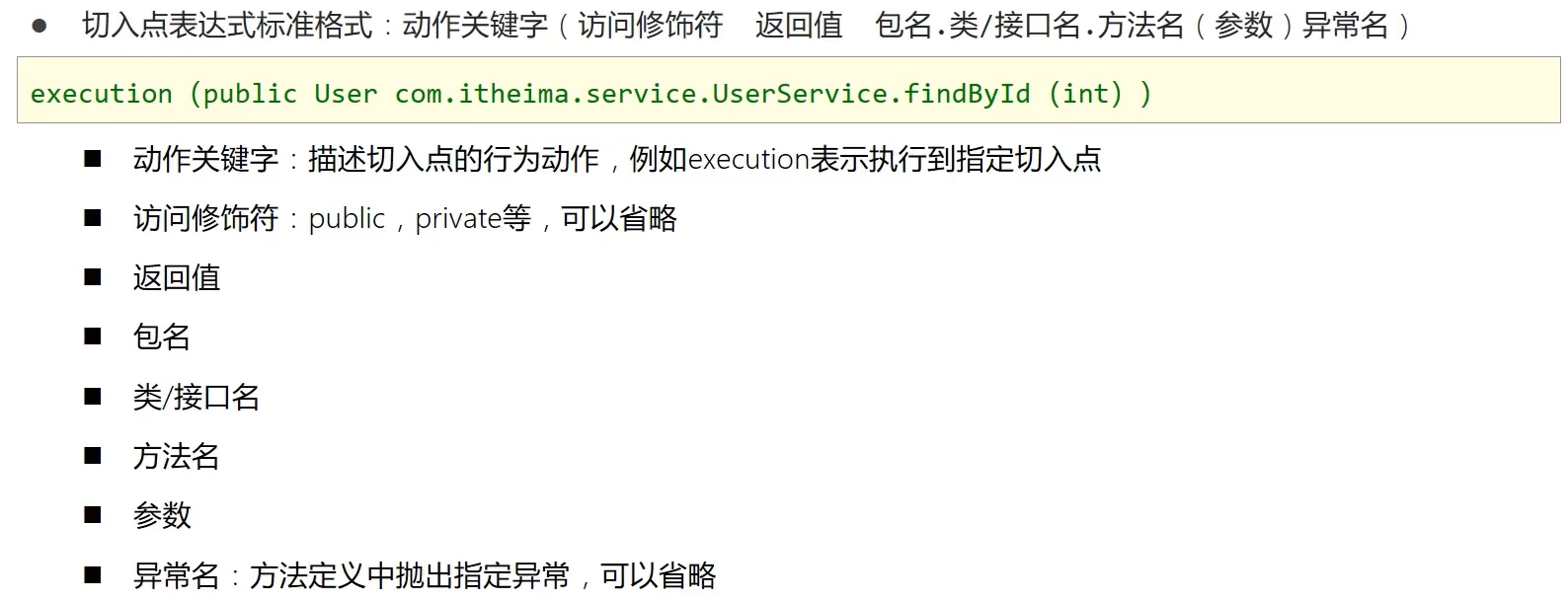
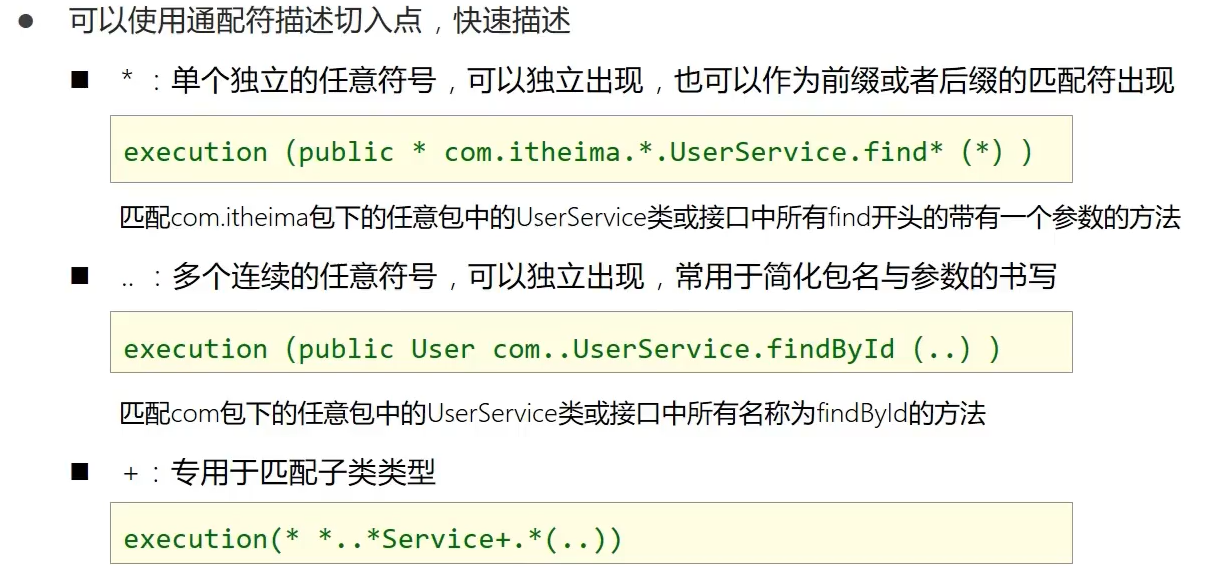
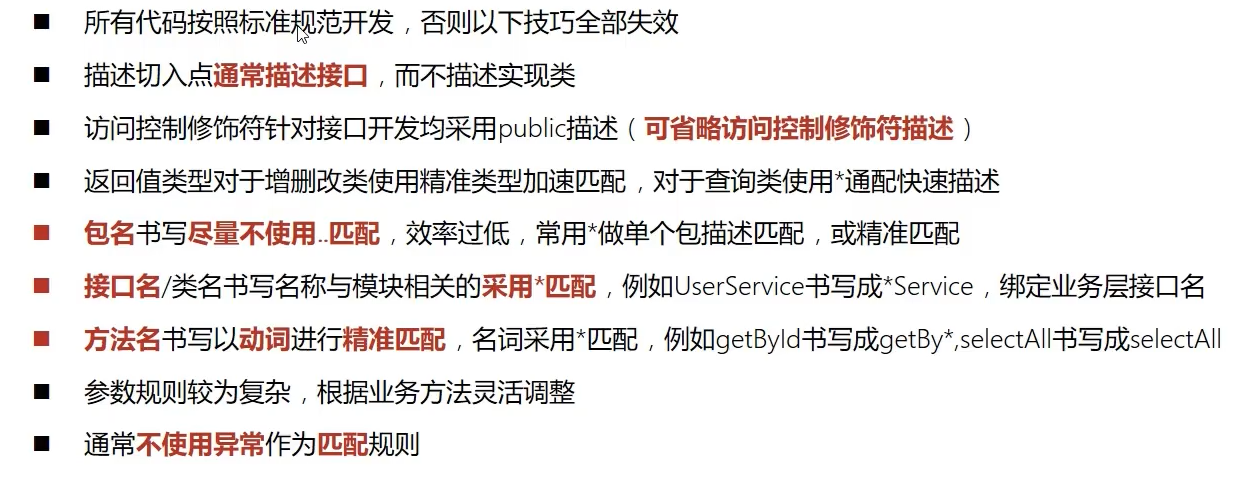
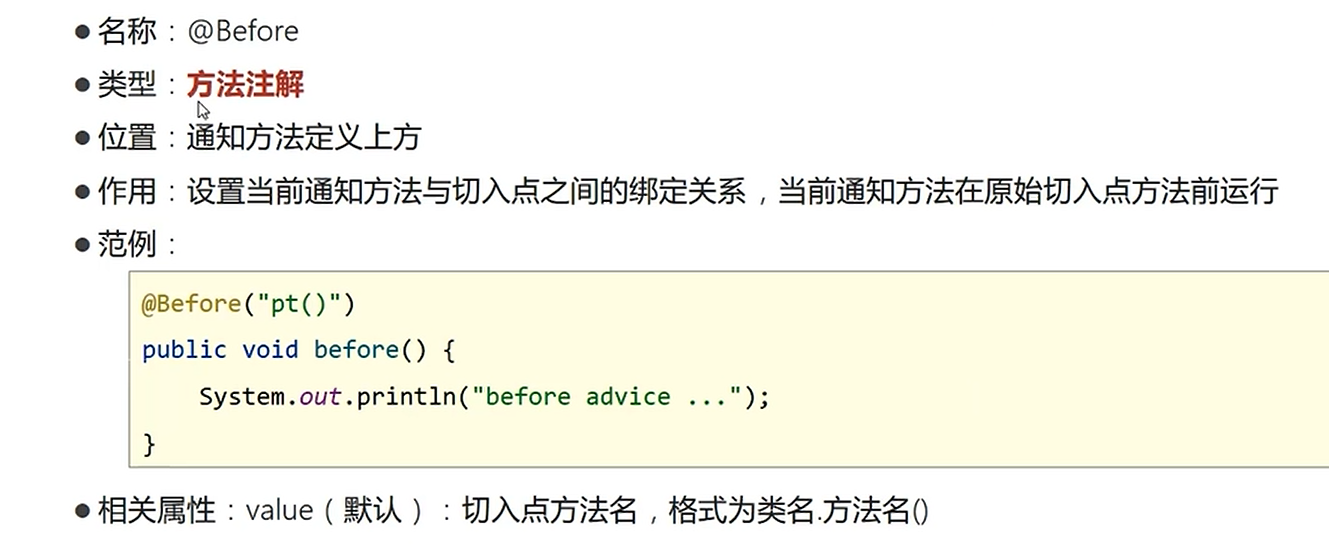
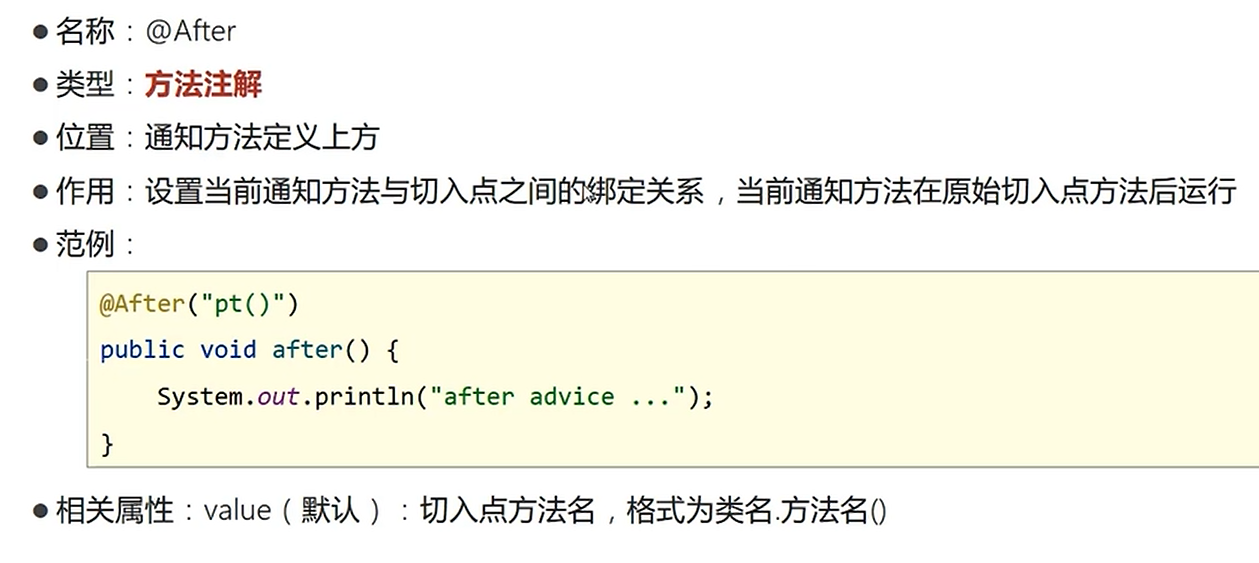
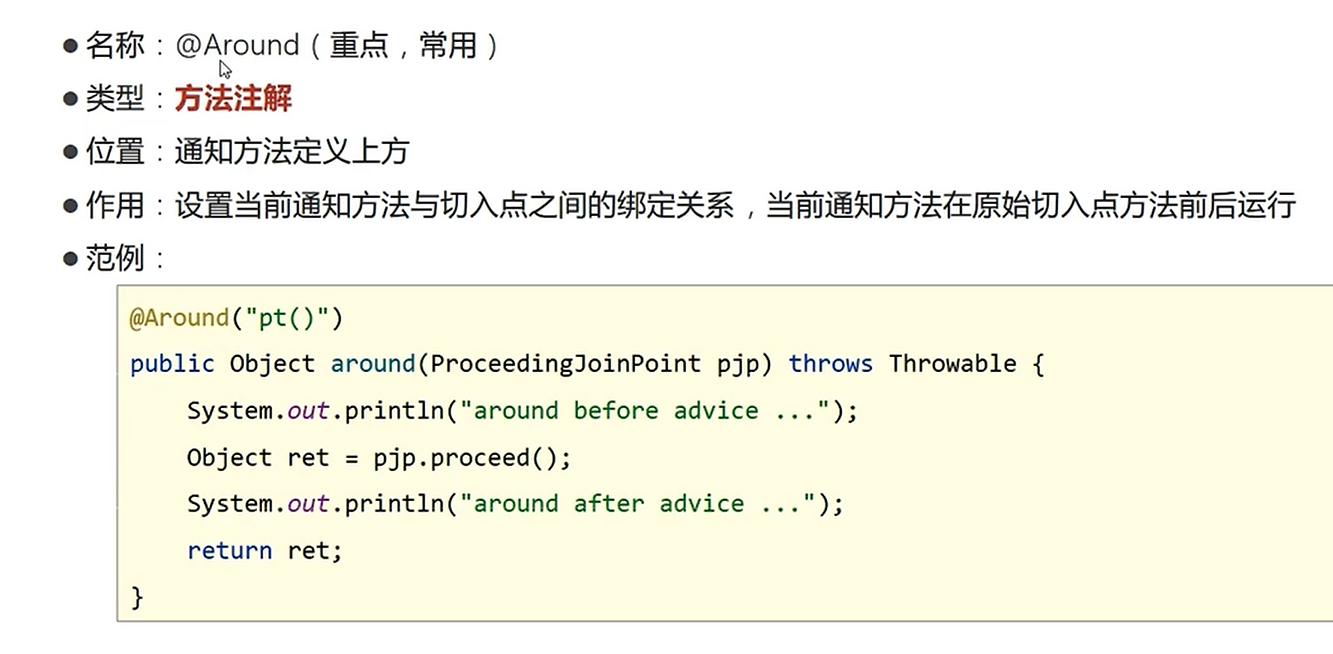
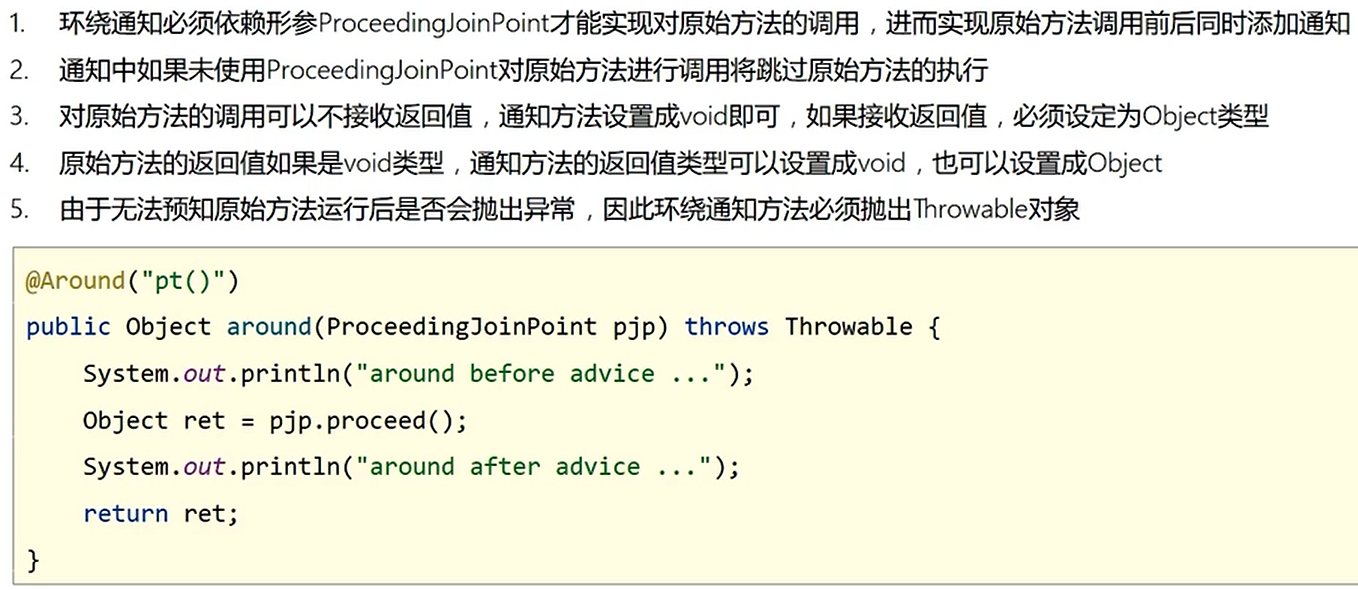
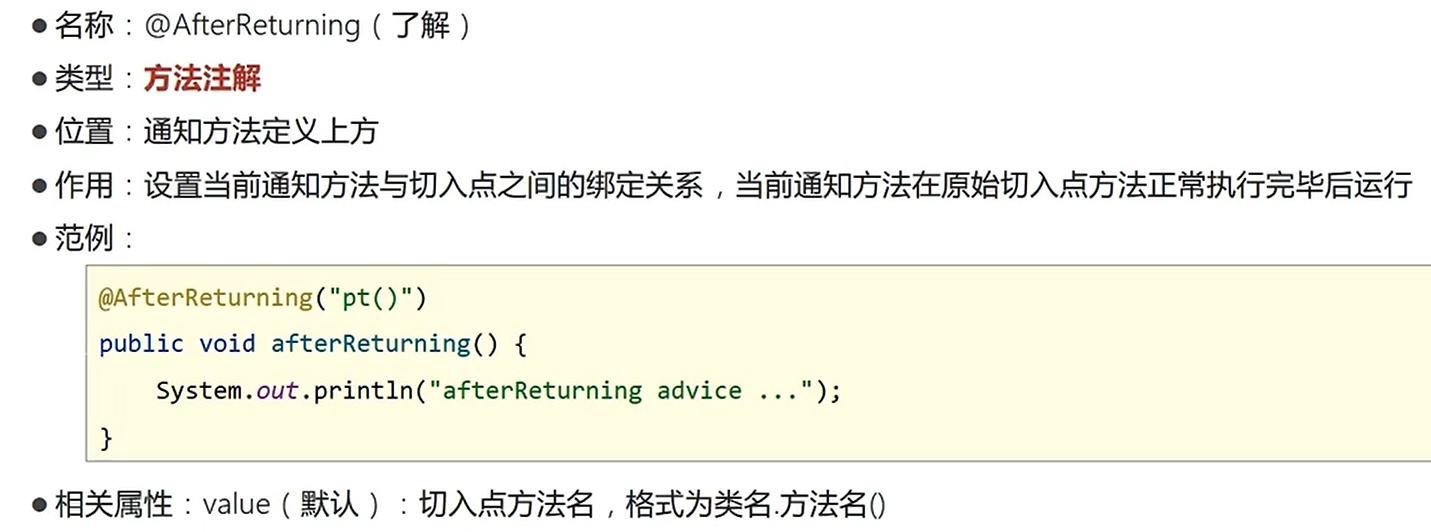
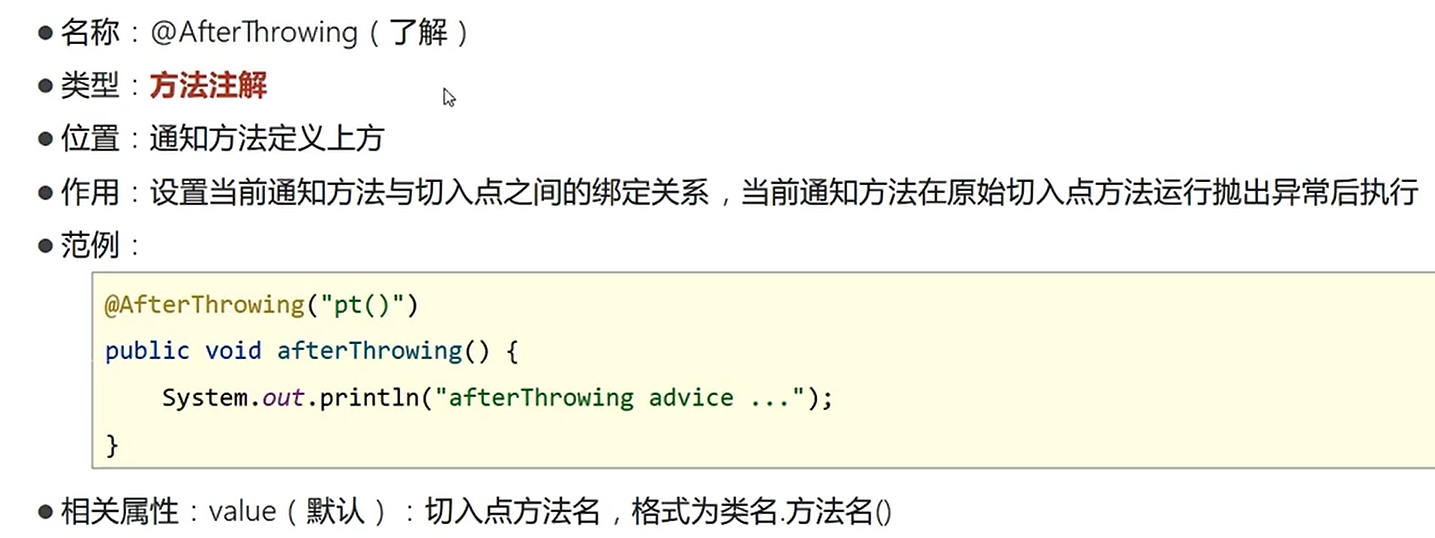

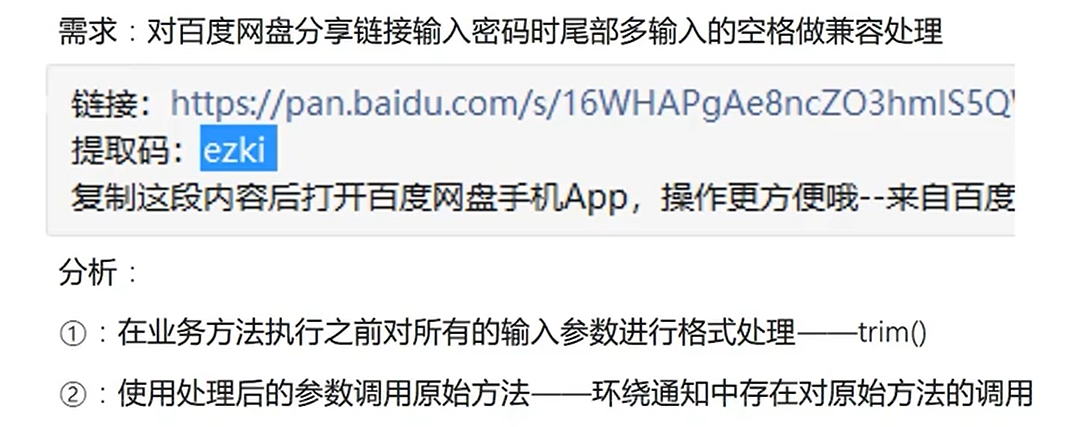

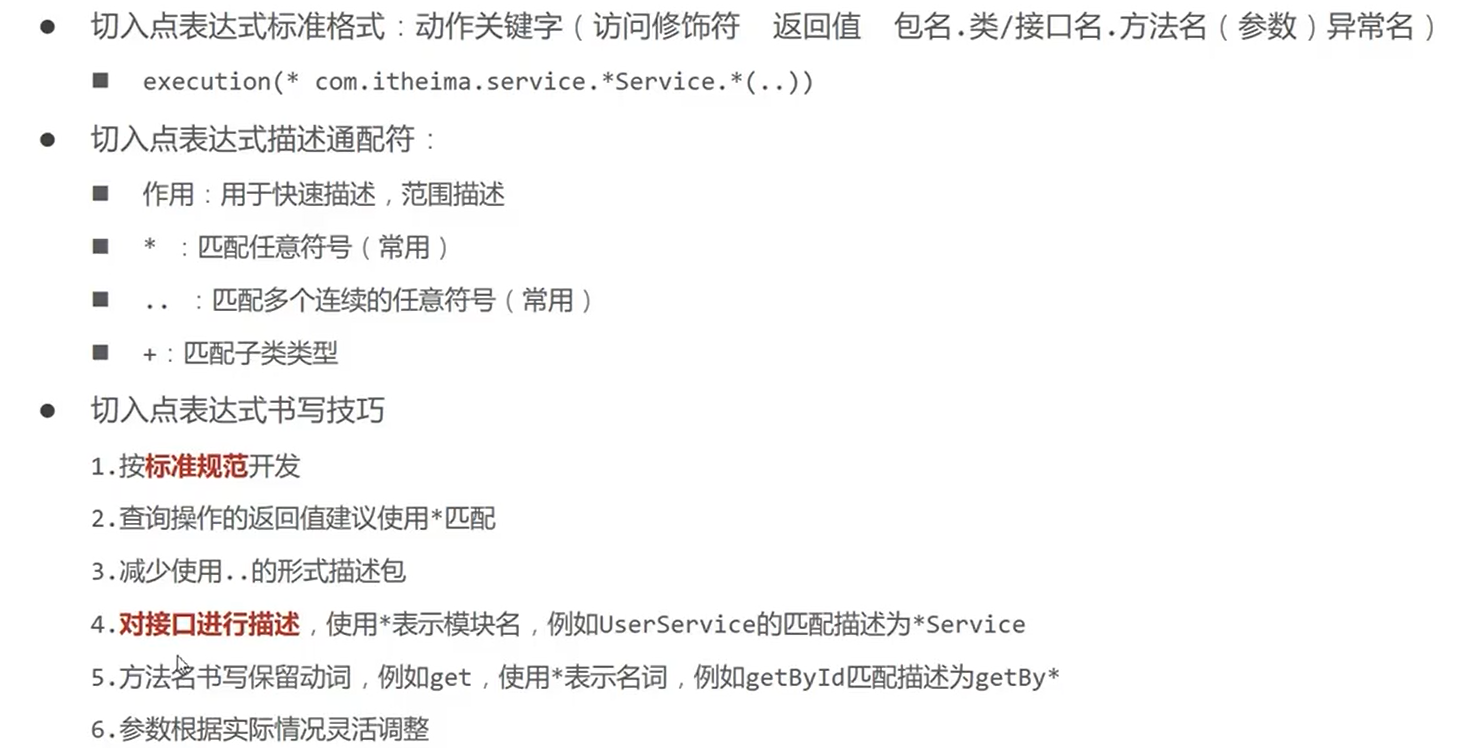
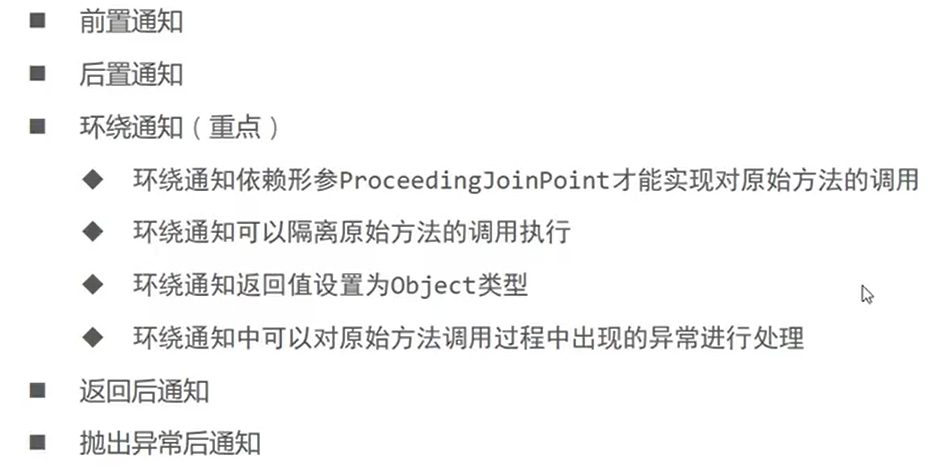
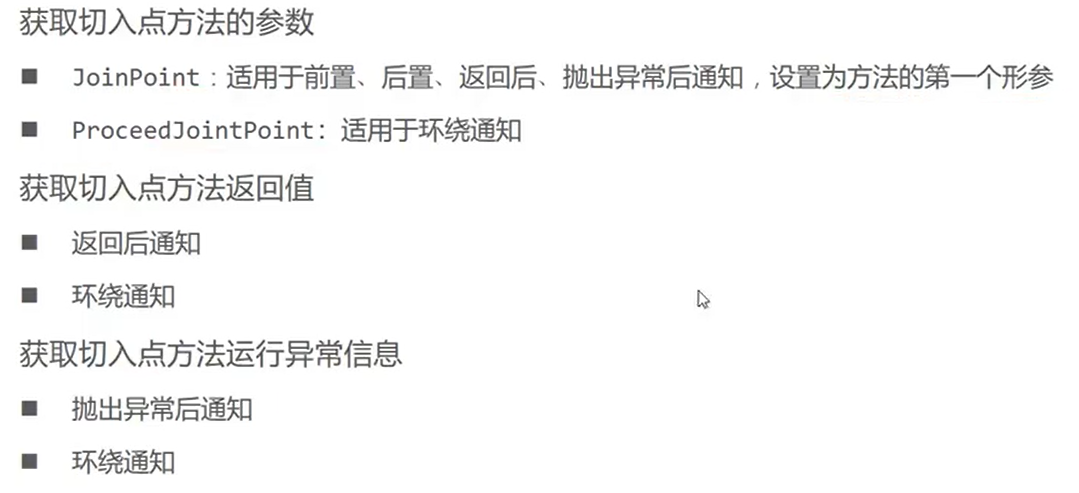

Comments | NOTHING